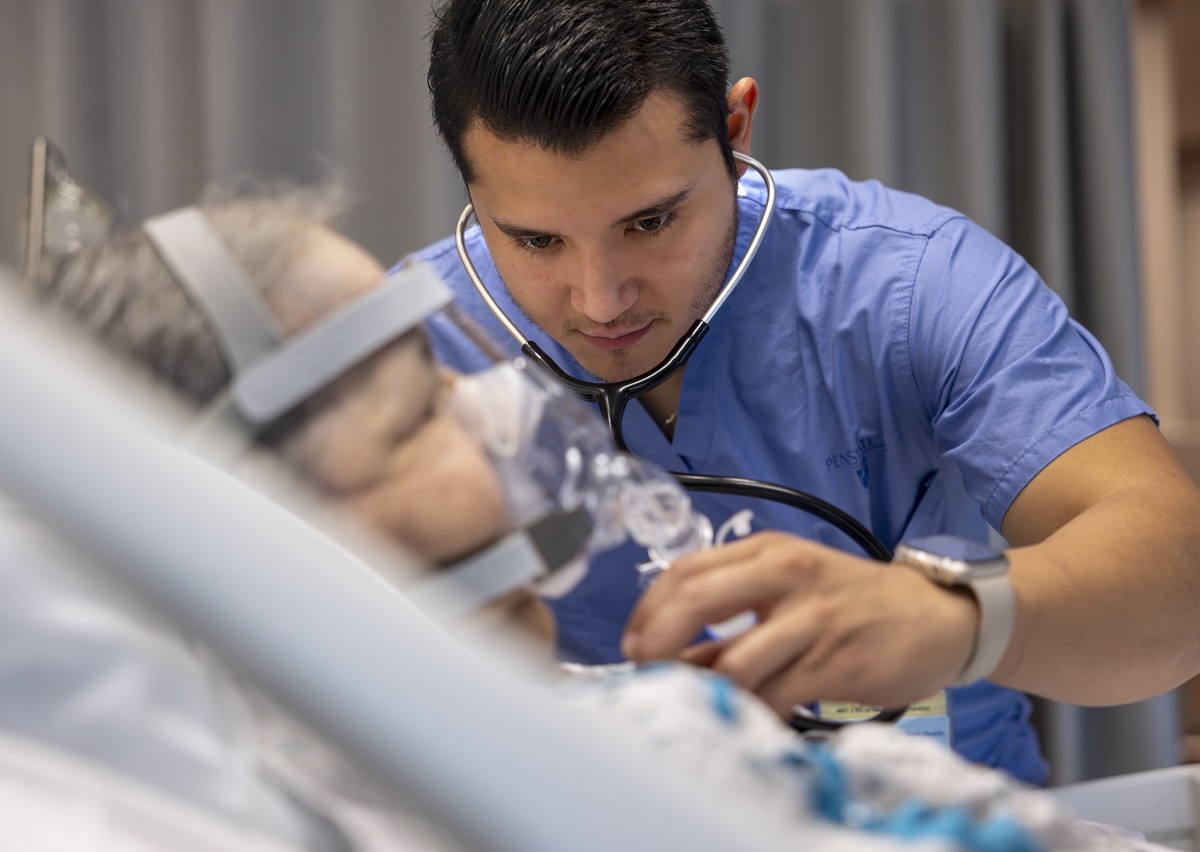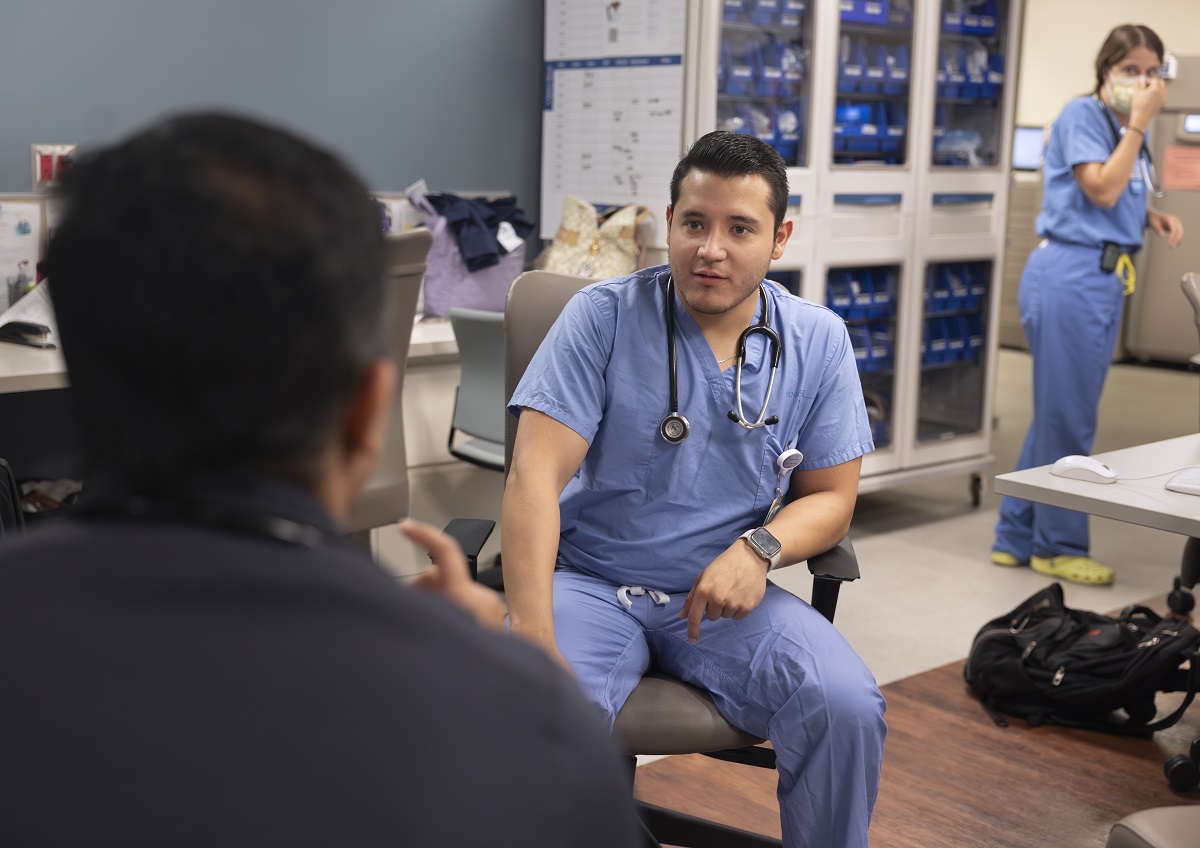‘El buen doctor’: Penn State Health resident works to improve care for Hispanic patients

Dr. Raul Vazquez Urrutia is “the good doctor.”
The second-year resident at Penn State College of Medicine earned that nickname while caring for a Puerto Rican patient with leukemia during his medical training.
A native of Guadalajara, Mexico, Vazquez Urrutia knew the patient faced not only a difficult diagnosis but also communication barriers in the U.S., where English is the primary language.
“I guided the family through the entire process, from informed consents to explaining upcoming steps in care,” he said. “The patient’s father would always greet me with ‘The good doctor is here,’ whenever I entered the room. My presence made them feel relieved.”
That connection inspired Vazquez Urrutia to assist the family throughout treatment, even when he wasn’t directly caring for the man. “I wanted to make sure they fully understood the complex diagnosis. Even when the patient was admitted to the hospital, I would still visit every day to talk to him.”
Roadblocks to care
While that patient is doing well, the challenges he faced with getting health care aren’t unique. Members of the Hispanic/Latino community often face barriers in accessing quality care. Penn State Health is working to address these obstacles.
Some of the key factors that hinder access to timely health care are:
- Locations of medical facilities and lack of available transportation
- Language ability and lack of health-related educational resources in Spanish
- Lack of health insurance or inadequate coverage
- Work demands that make it difficult to schedule medical appointments and increase the likelihood of advanced illness
- Lack of trust in medical systems
- Concern about immigration consequences if the person is undocumented
“As a first-generation immigrant,” Vazquez Urrutia said, “I understand the challenges of moving to a new country and starting anew. I often provide advice to newcomers to help them navigate these challenges.”
Breaking the language barrier
Vazquez Urrutia attended medical school in Mexico and then moved to the U.S. to advance his training and grow professionally. He uses his background to help bridge the cultural divide in health care.
“I work at Penn State Health Internal Medicine at the Cocoa Outpatient Center in Hershey as one of the few Spanish-speaking providers. Being medically trained in Spanish, I have the pleasure of caring for the Spanish-speaking population, who have specific needs, particularly with access to care and health insurance.” Because language barriers can result in missed appointments or follow-up care, he will call patients to clarify diagnoses or medications to make sure they fully understand their treatment plans.
To reduce language barriers, the Penn State Health Office for Diversity, Equity and Inclusion offers conversational Spanish courses to employees. A corollary effort involves increasing the number of bilingual employees who are qualified or certified medical interpreters. Penn State Health also uses LanguageLine, a translation service company that provides remote video interpreting services for patients.
Vazquez Urrutia, who will complete his training in 2026 and be board-certified in internal medicine, applauds any efforts to involve Spanish-speaking personnel in tasks such as discharge instructions and follow-up recommendations.
“Many people don’t realize the growing Spanish-speaking population in the area and their specific needs. By incorporating this awareness in processes such as job offers and creating descriptive literature about our growing Hispanic population and the need to increase health care access for them, you could attract more Spanish-speaking professionals,” he said.
Personal loss prompts research
The leukemia patient Vazquez Urrutia cared for isn’t an isolated example. American Cancer Society statistics from 2021 to 2023 show that cancer is the leading cause of death among the U.S. Hispanic population. Research available through the National Institutes of Health shows that Hispanic patients are diagnosed with acute leukemias at a younger age, have higher rates of the disease and face worse outcomes.
Planning to apply for a hematology/oncology fellowship after his training is complete, Vazquez Urrutia hopes to change those statistics. “I cared for several cancer patients and, unfortunately, witnessed many poor outcomes, including the loss of my grandmother within 12 months of her diagnosis. This personal experience fueled my interest in researching better care for cancer patients,” he said.
He began that research during his last year of medical school, focusing on immune cell function against cancer and microRNAs. “These are molecules that modify genetic expression,” he explained. “When I started my residency, I enrolled in a research track and eventually found a mentor who shared my background in miRNA research. Together, we aim to improve CAR T-cell therapy.” This leading-edge treatment uses a patient’s own genetically modified T cells to treat certain blood cancers, including leukemia.
Partnerships advance health equity
Beyond these efforts to improve care for Hispanic/Latino patients, Penn State Health partners with various community organizations to increase cancer-related educational resources, promote access to healthy food and respond to the needs of underserved patients through community-based clinics and outreach programs.
The health system also continues to emphasize workplace diversity. One initiative is the Hispanic/Latino Professionals Association, a health system Business Employee Resource Group that promotes an inclusive and equitable culture for Hispanic/Latino professionals.
“The group’s members strive to create workplaces that reflect the communities we serve while promoting health equity by reducing disparities in care,” said Lynette Chappell-Williams, vice president and chief diversity officer.
If you're having trouble accessing this content, or would like it in another format, please email Penn State Health Marketing & Communications.

